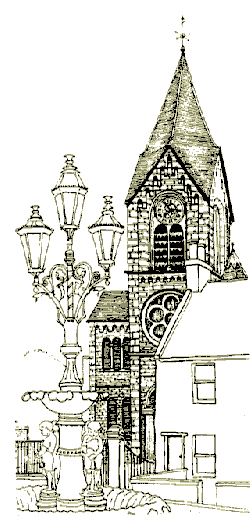

If the parish bounds have remained constant through the centuries, the name certainly has not. In 1342, 'the church of Hauche, called the prebendarie of Lintoune' was annexed to the newly created collegiate church at Dunbar. This name (which appears also as 'halch' or 'haugh') derived from the situation of the church close by a riverside meadow. In time, 'the priest's toun' (or Preston : the settlement of the priest) came to be associated with it, giving 'Prestonhaugh'. As such it was known until the early eighteenth century when the present name of 'Prestonkirk' came more generally into use.
The parish in the course of its history has been served by a long line of clergymen. In the Middle Ages, it was not uncommon for these to be younger sons of the local aristocracy and a notable succession of Hepburns, relatives of the Hepburn lords of Hailes Castle (later the Earls of Bothwell), held the position before and after the Reformation in 1560.
![]()
 |
The most distinguished though was Gavin Douglas (died 1522), the third son of Archibald 'Bell-the-Cat', fifth Earl of Angus and lord of Tantallon Castle. Beginning his ministry here, Gavin Douglas became Provost of St Giles, in Edinburgh, in 1503 and eventually Bishop of Dunkeld. It was not, however, as a cleric that he found lasting fame but as a makar, or poet; his Eneados, a translation into Scots of Virgil's Aeneid, remains a classic to this day. His allegorical poem The Palice of Honour was probably written during his ministry at Prestonhaugh.
In the Middle Ages there were chapels elsewhere in the parish dependent on the church here. One was at Hailes Castle, the chief lordly residence in the parish, and another lay at Waughton Castle, in the north of the parish, a residence of a branch of the Hepburns. A third, St Mary's, was at Markle, a manor house in the west of the parish also associated with the Hepburn name. Since the Reformation of the Church in 1560, two other Protestant churches have been established within the parish, the result of religious differences of opinion. About 1770, the United Presbyterian Church (now in use as the Masonic Hall) was built in Tyne Close in the growing town of Linton, and following the Disruption of the Church in 1843 the Free Church of St Andrew,s was erected in The Square at the south end of the High Street. Both churches had manses built for their ministers; the Free Church manse was built on the site of Linton's whisky distillery! The two denominations united in 1900 to form the United Free Church, and that Church made a union with the Church of Scotland in 1929. In 1959, the two congregations were reunited under one minister. |
|
| St. Andrew's, East Linton |
Follow the links below for more information about Prestonkirk
Back to introduction